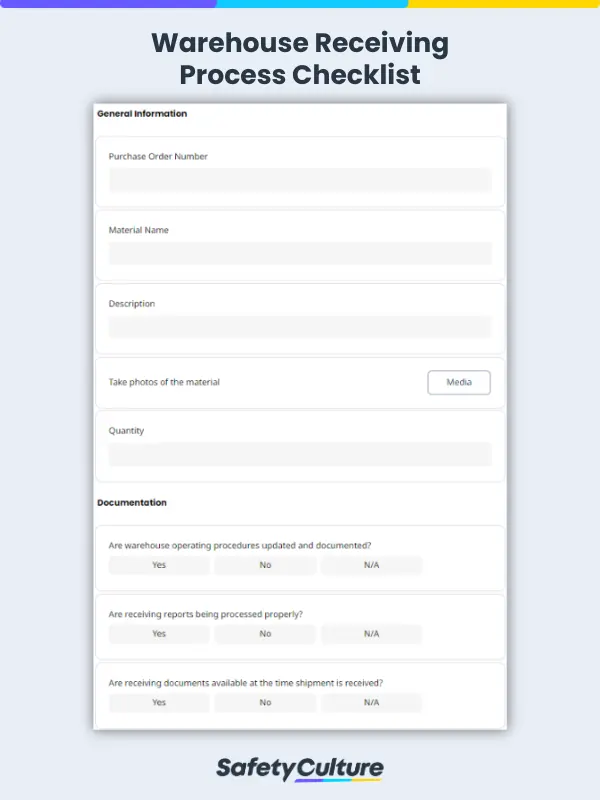What is the Warehouse Receiving Process?
Warehouse receiving is the process of checking the condition of newly-arrived items, materials, or supplies upon delivery and before they are added to a company’s warehouse inventory. This process helps inspect the quantity, quality, condition, and functionality of incoming products, ensures that items are stored in appropriate locations, and helps in promptly identifying any issues with the supplier.
Receiving inspectors and warehouse inspectors oversee this process and review the steps starting from quality checks upon arrival, to secure unloading from delivery trunks, and up to the proper storage of the goods in the warehouse. This also helps ensure that all items in the inventory are accounted for.
As part of the whole supply chain process, an organized process of warehouse receiving can help make inventory management and warehouse management be more efficient, cost-effective, and accurate.
Consequences of an Unoptimized Warehouse Receiving Process
Not having an organized warehouse receiving process can lead to various disadvantages and consequences in the performance of the procedure. It can even affect business operations on a bigger scale, especially if the issues are consistently not addressed. An unoptimized warehouse receiving process is costly, time-consuming, and can lead to:
- Inaccurate stock numbers – Failure to declare the correct number of items in stock leads to inaccurate inventory numbers, increases inventory costs, and even affects the whole operational efficiency of a company. Unmet expectations due to stock-related issues also inevitably affects customer experience and satisfaction.
- Material stockout and material overstock – In relation to inaccuracy in stock numbers, an unoptimized warehouse receiving process can also cause material stockout (i.e., products become unavailable from the inventory) and material overstock (i.e., excess or surplus of products in inventory), which both result in loss in sales and resources.
- Substandard items – One of the main purposes of the warehouse receiving process is to check the quality and condition of the items before they are accepted and added to the inventory. The inability to perform necessary inspections can result in failure to catch items that are not functioning properly, or if there are materials that are not of the optimum quality.
- Issues in inventory storage and location – Lack of proper documentation prevents real-time and accurate reporting of the current state of the whole receiving procedure. This can result in inefficient storage processes and can even lead to loss of resources when materials are not stored properly.
- Disruption in supply chain – As an integral part of the whole retail supply chain, failure to proactively manage warehouse receiving processes can result in oversight of issues, interruption in distribution of goods, and can even cause supply chain disruption.
Proactively addressing the items above from the start is a company’s best defense in preventing these issues to affect their whole operational process. Additionally, success at this stage of the supply chain can help increase the profitability of the business as a whole.
How to Improve the Warehouse Receiving Process
Companies utilize different ways to improve their operational processes in order to function efficiently. A comprehensive warehouse receiving process is essential in determining areas for improvement and avoiding inefficiencies in the procedure. Below are tips to help ensure an effective warehouse receiving process:
Ensure accurate documentation and reporting
Supply and retail chains do not just involve the company itself but other third-parties such as suppliers, vendors, and facility providers—so proper documentation is essential in maintaining a systematic warehouse receiving process. Ensure that documents are updated and include key information such as transportation schedules, name and number of items expected, and name of supplier and address, among others.
Use proper labeling
Proper labeling helps ensure that materials are easily identifiable. This reduces the probability of mistakes such as sending incorrect items to customers and mishandling goods that should be treated with care.
Replenish items correctly
An accurate replenishment process allows for an efficient inventory and storage system. This lessens the chance of stock-related issues and prevents them from negatively impacting the whole supply process.
Perform consistent inspections and audits
Quality checks before accepting and receiving materials are important in maintaining a healthy status of warehouse stocks. Periodic inventory audits also help in catching inaccuracy in supply numbers and help ensure that they are addressed before they further affect the succeeding receiving processes.
Utilize technology
Businesses can also utilize technology to efficiently manage inventory and warehouse systems. One of these is an automated data-collection system called Radio Frequency Identification technology (RFID), which increases efficiency in the process of receiving by scanning items in larger volumes and at higher speeds.
All these may be daunting to manually perform and keep track of but companies can always use tools that can help in inspecting, auditing, recordkeeping, and monitoring the trends and status of operations across all processes.
What is a Warehouse Receiving Process Checklist?
A warehouse receiving process checklist is a tool that receiver inspectors or warehouse inspectors use to ensure an organized procedure of receiving incoming materials for inventory. Through the use of an efficient checklist, businesses can prevent inaccuracy in inventory stocks and help ease the tracking process of items in the warehouse.
A comprehensive warehouse receiving process checklist contains a step-by-step guide on what to ask and check for when receiving, unloading, and storing newly-delivered items. It also helps in proactively identifying if there are discrepancies in the quantity and quality of the items, allows for proper documentation, and helps in spotting any irregularities with the whole process.
Although elements of a warehouse receiving process checklist may vary according to the specifics of a business, it should essentially be detailed and help accomplish the overall goal of ensuring that the process is done efficiently and effectively.
What to Include in a Warehouse Receiving Process Checklist?
To ensure an efficient warehouse receiving process, use a warehouse order checklist and include the following items:
- Date and Time of Delivery
- Supplier Name & Address
- Delivered By
- Received By
- Purchase Order Number
- Material Name
- Description
- Photos of the item
- Quantity
- Documentation
- Receiving Inspection
- Unloading
- Inventory



